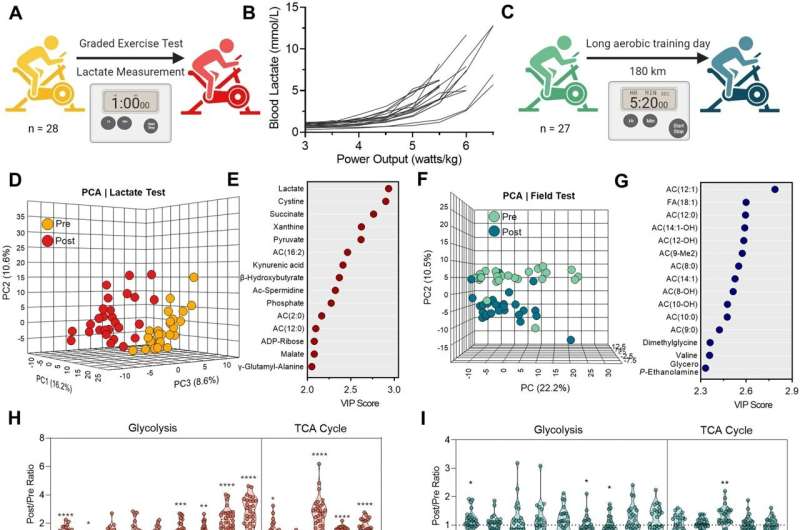This article has been reviewed according to Science X's editorial process and policies. Editors have highlighted the following attributes while ensuring the content's credibility:
fact-checked
trusted source
proofread
Blood of elite cyclists holds clues to treating and preventing chronic diseases

Examining metabolites in the blood of elite cyclists can help treat and prevent chronic diseases, according to a new study from researchers at the University of Colorado Anschutz Medical Campus.
The study was published today in Sports Medicine.
The scientists studied the metabolism of elite professional cyclists during training and in a world tour race by using metabolomics, a technique that allows them to study thousands of metabolites from just a few drops of blood. Metabolites are small molecules made when the body breaks down food, drugs, chemicals or its own tissues.
Traditionally, researchers have had to freeze the blood right after it's taken, but the CU Anschutz team adapted a protocol to dry the blood, allowing them to follow the cyclists into the field and monitor their performance in a real-world setting.
"We're focusing a lot on what happens to the mitochondrial function of cells. This mitochondrial function is what we see dysregulated in so many diseases," said Iñigo San Millán, Ph.D., a study co-author and assistant professor in the Division of Endocrinology, Metabolism and Diabetes at the University of Colorado School of Medicine. "If we can get signatures without having to be invasive, we can detect dysregulations of key areas ahead of time, before a disease develops."
San Millan said researchers focused on elite athletes because they come closest to representing physical perfection from a fitness point of view.
"We cannot understand imperfection—such as multiple metabolic diseases—if we don't understand perfection in the first place," he said.
Travis Nemkov, Ph.D., the lead and co-corresponding author of the paper and assistant research professor in the Department of Biochemistry and Molecular Genetics at the CU School of Medicine, said the study shows the feasibility of using this technology to monitor sports performance and when combined with a dried blood collection technique, makes this technology available to more athletes of all persuasions—professionals or weekend warriors.
It will lead, he believes, to a more personalized exercise-as-medicine approach that will help protect those at risk for certain conditions like diabetes and heart disease and offer potential treatments for patients already diagnosed.
"By identifying these healthy metabolomic signatures, we are able to take that information into patient populations with health complications, like those who are cancer survivors or those who are suffering from symptoms of long COVID," Nemkov said.
Angelo D'Alessandro, Ph.D., the senior and co-corresponding author of the study and professor in the Department of Biochemistry and Molecular Genetics, said one example of this was the discovery that patients who came into the clinic with long COVID had similar blood profiles to elite cyclists when they reached exhaustion. Collecting information like this could allow medical teams to create a more individualized exercise plan to get patients back to health.
"We believe this technique opens a window into a variety of potential new therapies for those suffering from metabolic diseases," he said. "There are tremendous possibilities ahead."
More information: Travis Nemkov et al, Metabolic Signatures of Performance in Elite World Tour Professional Male Cyclists, Sports Medicine (2023). DOI: 10.1007/s40279-023-01846-9




















